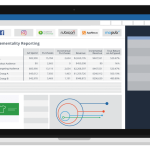Engagio CEO: The one-to-one relationship is the key driver behind marketing’s evolution
Jon Miller, who also co-founded Marketo, thinks customer data/campaign orchestration tools are coalescing, while interaction ones keep multiplying.

Marketing software has been evolving toward the goal of one-to-one marketing, says Engagio CEO and co-founder Jon Miller.
Miller, who also co-founded Marketo, told me that his career was inspired by the 1993 book, “The One to One Future: Building Relationships One Customer at a Time.” Written by customer strategy experts Don Peppers and Martha Rogers, it presented a vision of what might follow mass marketing.
Miller pointed out that the goal of a highly granular, targeted marketing could not be fully achieved at mass scale by the first generation of marketing automation tools, which have been largely rules-based. It needed a mature artificial intelligence to manage all those separate interactions with customers. (Miller will speak about “The Evolution and Future of Martech” at our upcoming MarTech Conference in Boston.)
But, while AI can relieve marketers of some tasks — Miller likens it to auto-pilot in a plane, where the pilot can focus on where the vehicle is headed — he also points out that marketers are beset by thousands of choices for software tools.
Those tools, he said, fall into three layers: Context, which provides the data needed to understand the customer; Orchestration, for coordinating the process of responding to the customer’s needs; and Interaction, where responses directly touch the customer.
“Marketers feel a little fatigue about how many different solutions are out there,” he said, adding that the pendulum may be swinging back toward more integrated platforms.

Engagio CEO and co-founder Jon Miller
If so, Miller expects that this consolidation of tools is more likely to take place in the layers of Context and Orchestration. Interaction tools, he predicted, will remain numerous and diverse simply because there are so many channels and ways to actually interact with customers and would-be customers – and those channels/modes are increasing.
The Context Layer, for instance, is seeing a trend toward collecting all customer-relating data into “a single point of truth,” whether called a Customer Data Platform or something else. Miller compares this layer to a nervous system, whose job is detection and monitoring.
The Orchestration layer is where AI makes its living, managing the best offers or responses at the right time in the right channel to each and every customer. It might be called a Customer Experience Orchestration Service, a real-time decisioning layer, or simply the operating mode of a platform, but, in any case, it’s the conductor of this grand symphony — or, in Miller’s metaphor, the brain in this three-layered environment.
Inside the Interaction layer lives the email provider, the social media marketing platform, the ad platform, and so on. For Miller, these are the muscles, making things happen in the real world of people.
Of course, the nervous system, brain and muscles in this creature can evolve in different ways for B2B and B2C environments. Miller suspects that, while Interaction tools will remain diverse for both, there’s a greater tendency in B2B for Context and Orchestration to end up in one platform, as in his current company, Engagio. It creates and measures engagement around account data, and it reaches out to other tools — like ad companies or email providers — to deliver the campaigns.
Whatever the evolutionary flow of marketing tools, it’s hard to predict fatigue. Even if tools in two of three layers tend to combine, or customer data coalesces around one repository, or AI makes auto-pilot the default mode, it’s entirely possible there will be other things to wear marketers out.
Marketing Land – Internet Marketing News, Strategies & Tips
(80)














